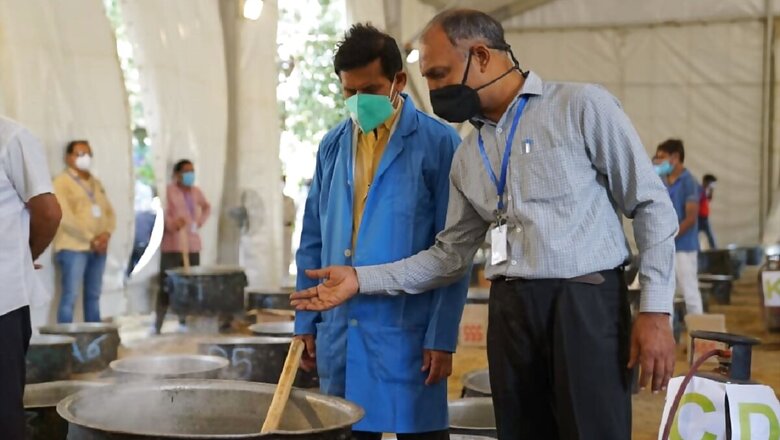
views
A signboard in white and green, and a tent pitched on the bylane in Hiranki village, Narela marks the location of the first site of the use of the Pusa bio-decomposer in the capital. Farmers and officers from the agricultural expension department are already present even though it is barely 8 am.
Prakash Vir and his son Sumit Rajput are out in their 15 bighas of land that they have taken on rent. With long crowbars, they move the residue of non basmati paddy (variety 1509) into small piles. Prakash says that they harvested the paddy about ten days back and come diwali, it will be time for the next crop, wheat. He is hopeful that by then, the Pusa bio-decomposer would have successfully decomposed the stubble.
“Last year, we used a tractor to shave off the paddy residue and filled the field with water for ten days and the parali decomposed, but the year before that we had set our parali on fire as all the farners here were doing it,” says Sumit, adding, “If this is successful, I would like to tell all my farmer brothers to go for this. Pollution is a serious issue and we also suffer because of it.”
Dinesh Kumar, agricultural extension officer in Hiranki explains, “For one acre of land, we need 200 litres of water mixed with 10 litres of the fermented bio-decomposer solution. For 3 acres here, we have 600 litres of water along with 30 litres of solution. Now, a tractor will be used to mix the stubble with the solution, which will turn into organic manure in 10 to 12 days. Depending on the moisture content, it may take upto 20 days.”
When we first reached out to farmers here, one of their key concerns was the number of days it would take for the parali to decompose, followed by whether it would harm their fields and the cost factors, says Ravinder Singh, another agriculture extension officer. Welcoming the use of Pusa bio-decomposer, he says, “We only take from the land and give back nothing but the land needs humus, organic matter among other things. If all the residue is decomposed, the land is happy.”
At around 11.30 am, a team from the IARI led by Dr K Annapurna also arrive to collect samples from the field that will help in analysing the efficacy of the bio-decomposer. “We are taking the samples before putting the Pusa decomposer to analyse the initial soil nutrient condition. After we put the decomposer, we will do the analysis once again to see the improvement. That will also tell us how much degradation has taken place,” she said. She further said that similar teams from the IARI will pick random samples from various other locations.
Dr Loveleen Shukla, IARI scientist, who has been credited with the innovation and was also present in Hiranki said, “It is the team work of division of microbiology and engineering, both of us had developed this technology, which basically deals with the microbial consortium that are lignocellulolytic in nature and when applied in the field, it will convert into compost. It can even be used in various sub strates ex situ also in pits, heaps.”We will be collecting the samples of before innoculation, then after 25 days and again after harvest to observe the changes and check the if there are any benefits. We want to give the farmers the confidence that instead of burning the paddy straw they can put decomposer in the soil.”
Asked whether this technology can be called a breakthrough or is it still at an experimental stage, Dr Roaf Ahmed Parry, scientist with the agricultural engineering division said, “At the insitututional level, we have had such demonstrations but in the feild, we had only experimented. This is the first time that we are having such a large scale demonstration, the purpose is same, we want to repeat the results we have obtained earlier in the field too.”
On a day when the AQI index touched ‘very poor’ category in various parts of the capital and reports of stubble burning in states neighbouring Delhi trickled in, Cheif Minister Arvind Kejriwal, who visited Hiranki and kickstarted the process as he expressed concerns over the rising levels of pollution. “The pollution was under control for the past 10 months but its on the rise again. I am worried about people of Delhi, as well as people of Punjab and Haryana.”
Asserting that more efforts need to be made, he called upon the various governments to work together to tackle the issue while staying away from blame-game. However, the chief minister also alleged that the central government could have done more to curb stubble burning but has not taken any action even on being approached by the Delhi government.
Calling for firm action, Kejriwal said, “The farmers of Punjab, Haryana, Uttar Pradesh and the people of Delhi are facing this trouble but the governments have turned a blind eye to the problem.”
This year, the Delhi government is using the Pusa bio-decomposer on approximately 700 to 800 hectares of land at a cost of Rs 20 lakh to itself. The fact that it is free is an additional attraction for farmers. Additionally, the same solution is also being used on an experimental basis in thousands of hectare across Punjab, Haryana, Rajasthan and Uttar Pradesh. Compared to the scale of stubble burning that Northern India witnesses every year, these numbers may be significant. The hope, however, lies in a possible breakthrough in cheap and viable alternatives to crop-residue burning for the farmer.
Read all the Latest News and Breaking News here




















Comments
0 comment